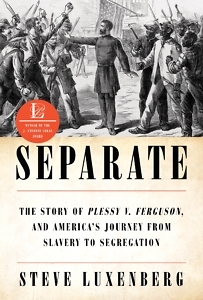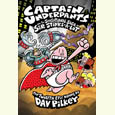Courting Jim Crow
Steve Luxenberg chronicles the characters behind Plessy v. Ferguson, the Supreme Court decision that sanctioned racial segregation
The landmark 1896 Supreme Court decision Plessy v. Ferguson sanctioned the notion of “separate but equal” and sped the adoption of Jim Crow laws and practices, shaping the history of the 20th-century South. In Separate, however, Steve Luxenberg looks back to the 19th century. His rich, soaring narrative chronicles the characters whose lives and ideas converged around Plessy, with all its tragic consequences for the American racial divide.

Luxenberg, a senior editor at The Washington Post for more than 30 years, is also the author of Annie’s Ghosts, an award-winning exploration of his family’s hidden past. As a work in progress, Separate won the J. Anthony Lukas Prize for excellence in nonfiction. It is a New York Times Editors’ Choice and has been longlisted for the 2019 Cundill History Prize. Luxenberg answered questions from Chapter 16 via email:
Chapter 16: We tend to think of Plessy as a beginning, helping to usher in the age of Jim Crow. But Separate ends with the case itself. What do we gain by looking backwards from 1896?
Steve Luxenberg: The Plessy legal battle arose from decades of resistance to separation in public accommodations of all sorts. It was a culmination as much as a beginning. The “untold story” has become a cliché in the publishing industry. It’s not a phrase I would use. Historians and constitutional scholars certainly have written about the case, particularly the legal ramifications. Separate takes on the challenge of telling the story through multiple characters, multiple eras, and multiple locations, with the goal of illuminating the broad debate over slavery, separation, and equal rights that dominated the national conversation for much of the 19th century. As one advance reader told me, “I studied Plessy in law school, and I thought I knew a fair amount about the case. Separate revealed how little I knew.”
Chapter 16: Henry Billings Brown, who wrote the majority opinion in Plessy, was a New England blueblood who lived in Michigan. Was Jim Crow just a Southern phenomenon?
Luxenberg: Not at all. Separation was born in the North, at the dawn of the railroad age in the late 1830s, when this new technology gave rise to the question, “Where do I sit?” No existing form of transportation, certainly not horseback or stagecoach, quite compared to a railroad car’s opportunities for throwing together passengers without regard for status or social group.
In Massachusetts, there weren’t many people of color, not even one percent of the population, and few had the means or need to ride the railroads. But three of the early companies insisted on having separate cars anyway. Five did not, proving that there was no consensus. The separate cars spurred protests from the abolitionist movement, which was always ready to seize on an issue. In 1843, the three companies ended the practice. But separation remained a custom that could be found throughout the North, on steamboats and trains, in theaters and churches.
In the South before the Civil War, the enslaved people weren’t riding the railroads. They were building them.
Chapter 16: John Marshall Harlan, who wrote the sole dissenting opinion proclaiming that the “Constitution is color-blind,” hailed from Kentucky. How and why did this Southerner emerge as a defender of black rights?
Luxenberg: Harlan’s evolution — from slaveholder’s son and pro-slavery politician in the 1850s to renouncing his past and championing the cause of equal justice — is a remarkable one for his time. His transformation was rooted in his political ambitions. After the Civil War, he could not bear the idea of working with the ex-Confederates who dominated Kentucky’s Democratic Party. In 1868, he joined the Republicans, the Northern party founded in 1854 to oppose slavery. The Republicans were weak, and when Harlan ran twice for governor (in 1871 and 1875), he knew he had no chance of winning. But his conversion brought him in contact with others who were more progressive. He still had strong prejudices, particularly toward the Chinese and immigrants. On the Supreme Court, in that body of nine white men from the ranks of the privileged and powerful, his views on equal rights for black citizens stood out.
 Chapter 16: Albion Tourgée, the lead litigator for the case, deserves admiration for his morally courageous activism on behalf of African Americans. He also led an extraordinary life as a Civil War veteran, judge, author, and diplomat. But he’s also kind of frustrating, isn’t he?
Chapter 16: Albion Tourgée, the lead litigator for the case, deserves admiration for his morally courageous activism on behalf of African Americans. He also led an extraordinary life as a Civil War veteran, judge, author, and diplomat. But he’s also kind of frustrating, isn’t he?
Luxenberg: Pick your adjective! Frustrating, infuriating, inflammatory, irascible, radical, pioneering. Tourgée was the best-known white advocate for civil rights in the late 19th century — as well as a fabled debater, a bestselling novelist, and a widely read newspaper columnist. He wasn’t, however, a Supreme Court regular. His involvement in the case was largely accidental. His strategy was to throw a wealth of arguments at the justices, probably not a wise choice. But I can’t imagine that a different approach would have worked. The court had laid out a cramped view of civil rights in its earlier rulings, and the Plessy case ended as expected, with a 7-1 decision (one justice did not participate) that said Louisiana’s legislature was exercising its “police powers” in enacting an 1890 law that called for “equal but separate” railroad accommodations.
Chapter 16: Rather than choose one character from New Orleans, you tell the history of the city’s wider elite, mixed-race class, who served as the basis for the Comite des Citoyens that launched the legal challenge leading to Plessy. Was this a practical decision, based on available sources and stories? Or was it more of an intellectual/political choice?
Luxenberg: I’ve never been accused of being practical in my writing choices. For me, New Orleans is a main character in the story. In the 19th century, no other city in the country could claim such a wealthy, educated, and militant group of people of color. That’s because many in the mixed-race community in New Orleans, the French-speaking Creoles of color, known as les gens de couleur libres, had never been enslaved. They and their ancestors had been free at the time of the American takeover. They had been agitating for equal rights for a long time, and their anger had been building for nearly a century. Separate pulls that thread through the narrative.
Chapter 16: Does Separate have something to say about today’s political landscape? What might the 19th century tell us about ourselves?
Luxenberg: Several reviewers have written admiringly about the book’s relevance. Eric Foner, in The Washington Post, wrote: “Separate reminds us that our history is not simply a narrative of greater and greater freedom. Rights can be gained, and rights can be taken away….We live at a moment not unlike the 1890s, with its retreat from the ideal of equality.” David Cole, in The Nation, said Separate “tells the story of how far our country had to go to repudiate its commitments to a racial double standard. A visit to any prison or inner-city public school today reveals how far we still have to go.” Racial justice has never come swiftly or easily in America. To see the lasting effects of the Jim Crow era, just look at the current statistics on economic and educational inequality. There’s proof of the perniciousness of “separate but equal.”

Aram Goudsouzian is a professor of history at the University of Memphis. His most recent book is The Men and the Moment: The Election of 1968 and the Rise of Partisan Politics in America.





